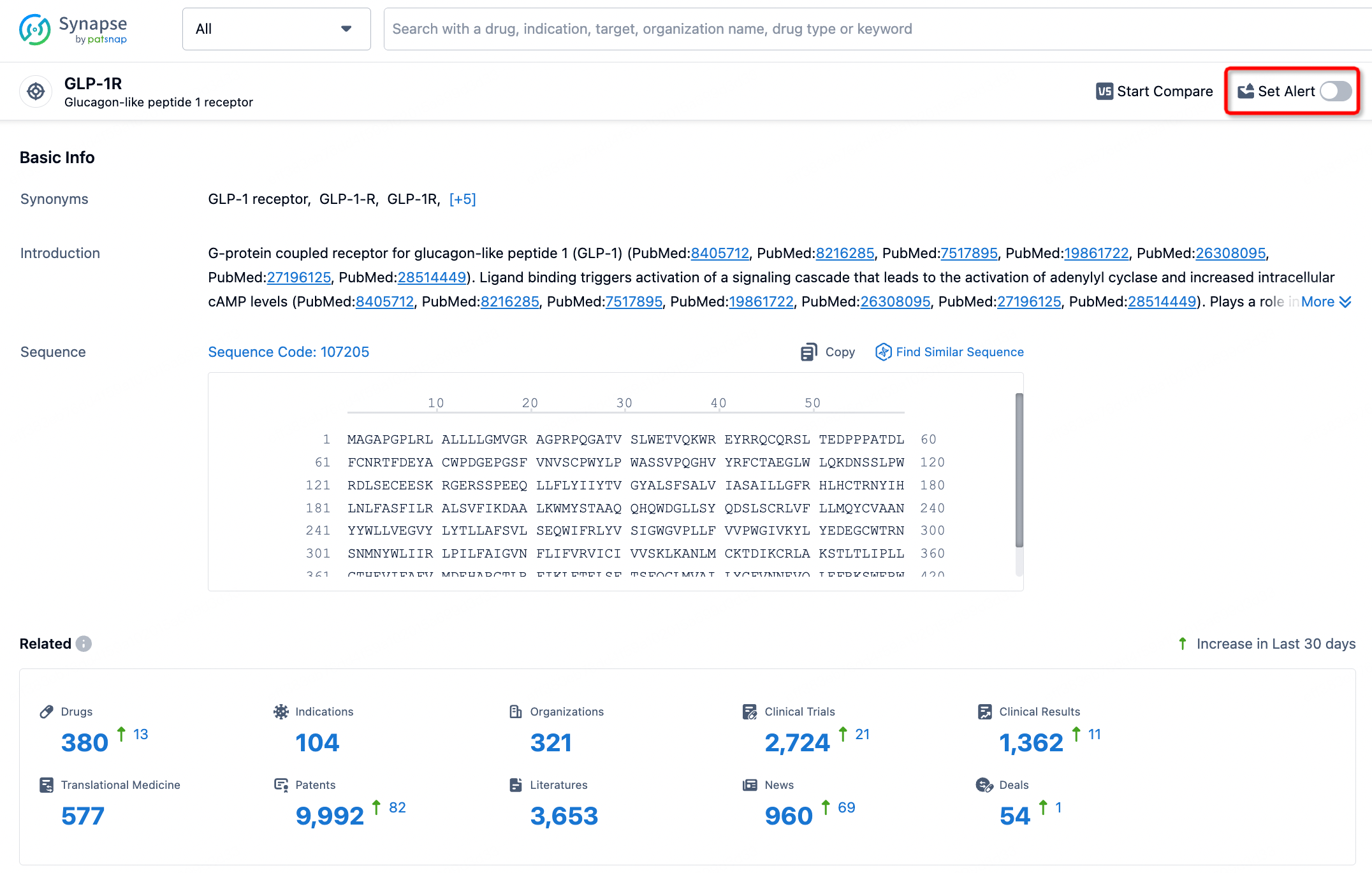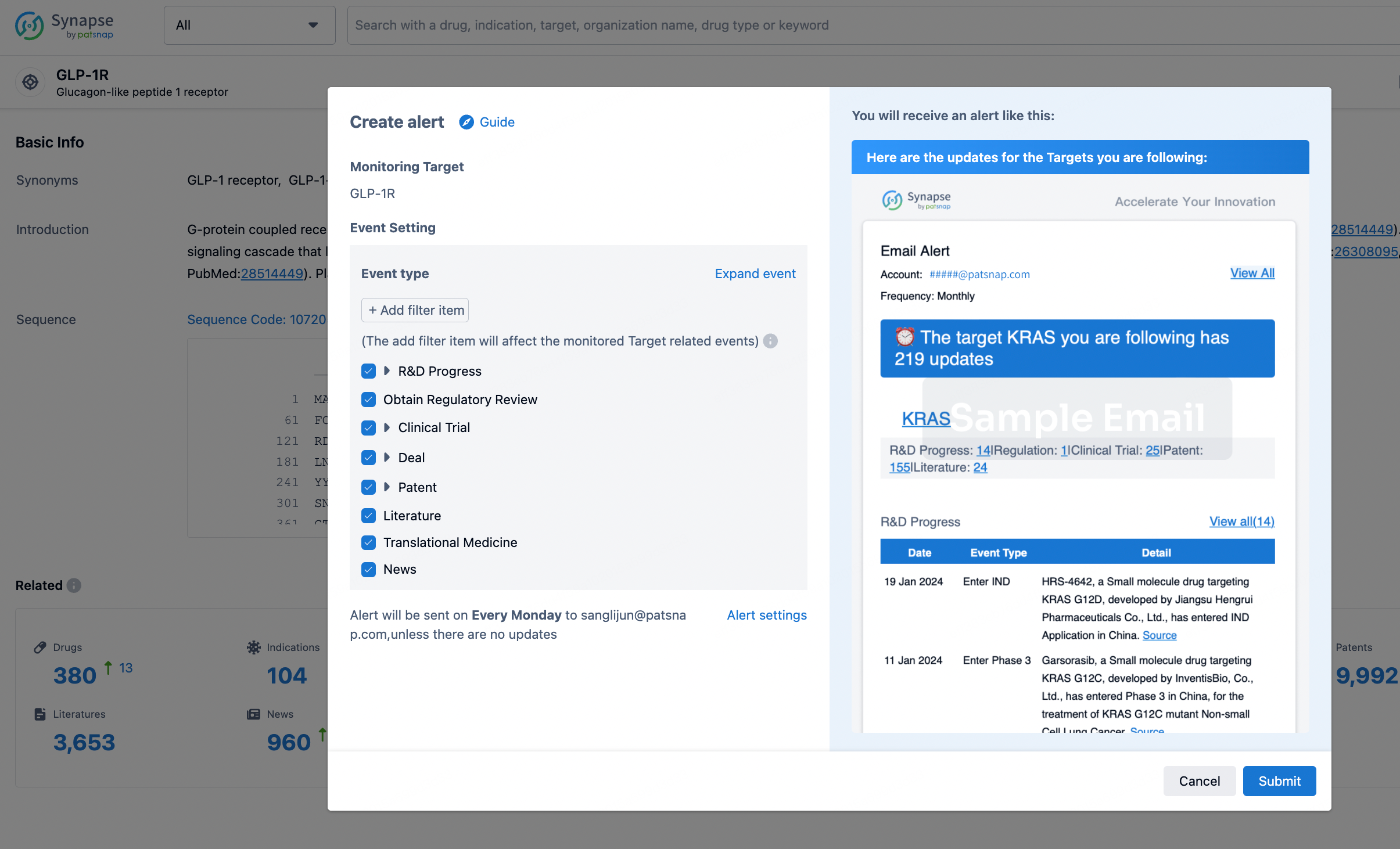Request Demo
What are GPR120 modulators and how do they work?
25 June 2024
In recent years, the search for novel therapeutic targets has led to an increased focus on G-protein coupled receptors (GPCRs), a large family of receptors that play crucial roles in various physiological processes. Among these, GPR120 has emerged as a particularly promising target due to its involvement in metabolic regulation and inflammation. Modulators of GPR120 are being studied for their potential to treat a variety of conditions, from obesity to type 2 diabetes. This blog post aims to provide an overview of GPR120 modulators, how they work, and their potential therapeutic applications.
GPR120, also known as free fatty acid receptor 4 (FFAR4), is a GPCR that is activated by long-chain fatty acids. This receptor is predominantly expressed in the intestines, adipose tissue, and certain immune cells. When activated, GPR120 can initiate a cascade of intracellular events that ultimately influence metabolic and inflammatory pathways. Given its strategic expression and functional capabilities, GPR120 has garnered significant interest as a therapeutic target.
GPR120 modulators work by either activating (agonists) or inhibiting (antagonists) the receptor. These modulators can be natural compounds, such as fatty acids, or synthetic molecules specifically designed to interact with GPR120. Upon activation by agonists, GPR120 triggers a series of intracellular signaling pathways, including the inhibition of cyclic AMP (cAMP) production and the activation of the mitogen-activated protein kinase (MAPK) pathway. These signaling events can lead to the secretion of incretins, hormones that enhance insulin secretion, and the release of adipokines that promote insulin sensitivity and anti-inflammatory responses.
Mechanistically, GPR120 activation has been shown to enhance glucose uptake in adipocytes and muscle cells, thereby improving insulin sensitivity. Additionally, activation of GPR120 in immune cells, such as macrophages, can shift these cells from a pro-inflammatory state to an anti-inflammatory state. This is particularly relevant in the context of obesity and type 2 diabetes, where chronic inflammation is a key pathological feature.
One of the most exciting areas of research involving GPR120 modulators is their potential use in treating metabolic disorders. Obesity and type 2 diabetes are global health concerns, and current treatment options are often inadequate or come with significant side effects. By improving insulin sensitivity and reducing inflammation, GPR120 agonists offer a novel approach to managing these conditions. Preclinical studies have demonstrated that GPR120 agonists can reduce body weight, improve glucose tolerance, and enhance insulin sensitivity in animal models. These promising results have paved the way for clinical trials to evaluate their efficacy and safety in humans.
In addition to metabolic disorders, GPR120 modulators are also being investigated for their potential anti-inflammatory effects. Chronic inflammation is implicated in a wide range of diseases, including cardiovascular diseases, neurodegenerative diseases, and certain cancers. By modulating immune cell function and reducing pro-inflammatory cytokine production, GPR120 agonists may offer therapeutic benefits in these conditions. For example, studies have shown that GPR120 activation can attenuate inflammation in animal models of rheumatoid arthritis and inflammatory bowel disease, suggesting potential applications in these and other inflammatory disorders.
Furthermore, GPR120 modulators may have applications in the treatment of liver diseases such as non-alcoholic fatty liver disease (NAFLD). NAFLD is characterized by fat accumulation in the liver, often accompanied by inflammation and insulin resistance. Given GPR120's role in regulating lipid metabolism and inflammation, its activation could potentially ameliorate the pathological features of NAFLD.
In summary, GPR120 modulators represent a promising avenue for the development of new therapeutic strategies for a variety of conditions, particularly those involving metabolic dysregulation and inflammation. By specifically targeting GPR120, these modulators have the potential to improve insulin sensitivity, reduce inflammation, and positively influence metabolic health. As research progresses, it will be crucial to evaluate the long-term efficacy and safety of these compounds in clinical settings. The future of GPR120 modulators looks bright, offering hope for new and more effective treatments for chronic diseases that currently pose significant challenges to public health.
GPR120, also known as free fatty acid receptor 4 (FFAR4), is a GPCR that is activated by long-chain fatty acids. This receptor is predominantly expressed in the intestines, adipose tissue, and certain immune cells. When activated, GPR120 can initiate a cascade of intracellular events that ultimately influence metabolic and inflammatory pathways. Given its strategic expression and functional capabilities, GPR120 has garnered significant interest as a therapeutic target.
GPR120 modulators work by either activating (agonists) or inhibiting (antagonists) the receptor. These modulators can be natural compounds, such as fatty acids, or synthetic molecules specifically designed to interact with GPR120. Upon activation by agonists, GPR120 triggers a series of intracellular signaling pathways, including the inhibition of cyclic AMP (cAMP) production and the activation of the mitogen-activated protein kinase (MAPK) pathway. These signaling events can lead to the secretion of incretins, hormones that enhance insulin secretion, and the release of adipokines that promote insulin sensitivity and anti-inflammatory responses.
Mechanistically, GPR120 activation has been shown to enhance glucose uptake in adipocytes and muscle cells, thereby improving insulin sensitivity. Additionally, activation of GPR120 in immune cells, such as macrophages, can shift these cells from a pro-inflammatory state to an anti-inflammatory state. This is particularly relevant in the context of obesity and type 2 diabetes, where chronic inflammation is a key pathological feature.
One of the most exciting areas of research involving GPR120 modulators is their potential use in treating metabolic disorders. Obesity and type 2 diabetes are global health concerns, and current treatment options are often inadequate or come with significant side effects. By improving insulin sensitivity and reducing inflammation, GPR120 agonists offer a novel approach to managing these conditions. Preclinical studies have demonstrated that GPR120 agonists can reduce body weight, improve glucose tolerance, and enhance insulin sensitivity in animal models. These promising results have paved the way for clinical trials to evaluate their efficacy and safety in humans.
In addition to metabolic disorders, GPR120 modulators are also being investigated for their potential anti-inflammatory effects. Chronic inflammation is implicated in a wide range of diseases, including cardiovascular diseases, neurodegenerative diseases, and certain cancers. By modulating immune cell function and reducing pro-inflammatory cytokine production, GPR120 agonists may offer therapeutic benefits in these conditions. For example, studies have shown that GPR120 activation can attenuate inflammation in animal models of rheumatoid arthritis and inflammatory bowel disease, suggesting potential applications in these and other inflammatory disorders.
Furthermore, GPR120 modulators may have applications in the treatment of liver diseases such as non-alcoholic fatty liver disease (NAFLD). NAFLD is characterized by fat accumulation in the liver, often accompanied by inflammation and insulin resistance. Given GPR120's role in regulating lipid metabolism and inflammation, its activation could potentially ameliorate the pathological features of NAFLD.
In summary, GPR120 modulators represent a promising avenue for the development of new therapeutic strategies for a variety of conditions, particularly those involving metabolic dysregulation and inflammation. By specifically targeting GPR120, these modulators have the potential to improve insulin sensitivity, reduce inflammation, and positively influence metabolic health. As research progresses, it will be crucial to evaluate the long-term efficacy and safety of these compounds in clinical settings. The future of GPR120 modulators looks bright, offering hope for new and more effective treatments for chronic diseases that currently pose significant challenges to public health.
How to obtain the latest development progress of all targets?
In the Synapse database, you can stay updated on the latest research and development advances of all targets. This service is accessible anytime and anywhere, with updates available daily or weekly. Use the "Set Alert" function to stay informed. Click on the image below to embark on a brand new journey of drug discovery!
AI Agents Built for Biopharma Breakthroughs
Accelerate discovery. Empower decisions. Transform outcomes.
Get started for free today!
Accelerate Strategic R&D decision making with Synapse, PatSnap’s AI-powered Connected Innovation Intelligence Platform Built for Life Sciences Professionals.
Start your data trial now!
Synapse data is also accessible to external entities via APIs or data packages. Empower better decisions with the latest in pharmaceutical intelligence.


